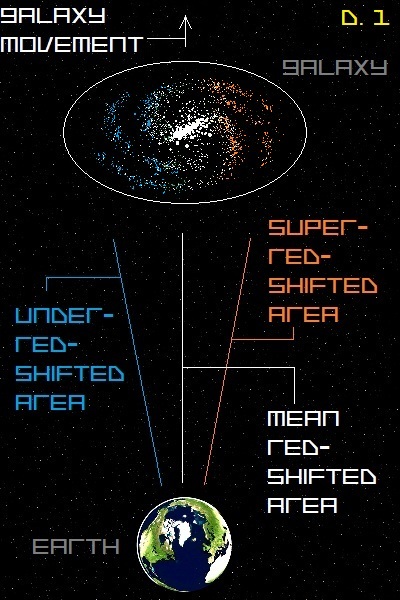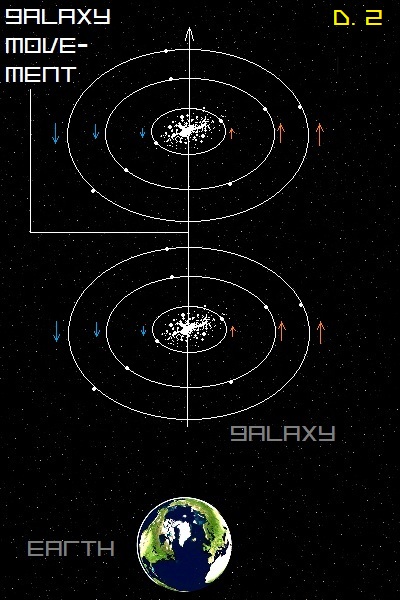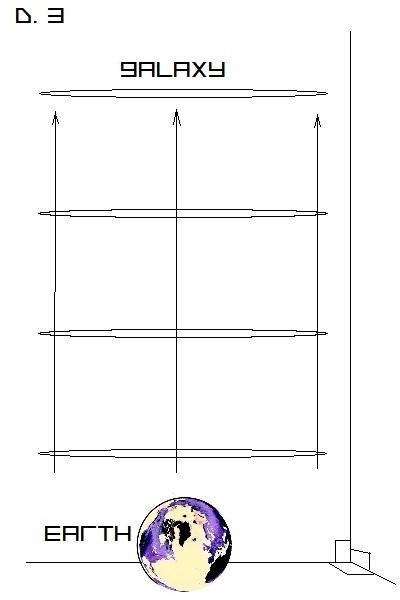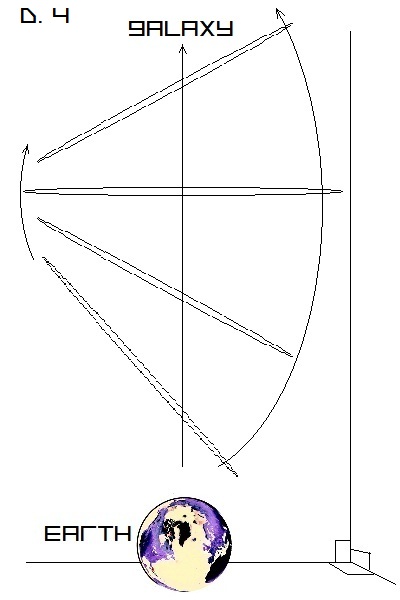It looks like you're using an Ad Blocker.
Please white-list or disable AboveTopSecret.com in your ad-blocking tool.
Thank you.
Some features of ATS will be disabled while you continue to use an ad-blocker.
share:
Okay. First of all I would like to thank those who visited my thread about the possibilty that the Universe's mass could be conserved under the form
of angular momentum energy.
But now that I think of it, we may not have to search for missing mass... I know what I'm going to say will sound incredible to my fellow physicist friends, but here it is: I think we might be searching for something which is not called for.
The reason why we think there is 90% (or 83%, according to some) of the Universe's mass missing, is because we saw something very important.
As you know, the Fizeau effect is as follow: When something rushes away from us, it redshifts, meaning that we perceive its outgoing photon's wavelenght as being stretched due to the speed of the rushing away. When something rushes toward us, we perceive its outgoing wavelenghts as shortened, or "blueshifted".
When we took a look at other galaxies, we saw they were all redshifted. So now we strongly believe they are all rushing away from us due to spacetime expansion. But that's not all. As we observed a "mean", general redshift of a whole galaxy, we also observed a slight exaggeration of redshift on the stars of one side of the observed galaxy, and slight under-redshift on the stars of the opposing side (see diagram 1: )

We interpreted this additional redshift as an evidence that these stars were rushing even faster from us, and had a superior orbital speed than previously thought:

It made sense: as the whole galaxy would travel, this extra orbital speed from its stars would show as a super-redshift (due to negative speed cumulation, see orange arrows in d. 2) on one side and a under-redshift on the other side (due to slight speed cancellation, see blue arrows in d. 2) of the rushing-away galaxy.
One little problem with that interpretation, this extra orbital speed doesn't match the calculated mass of the observed galaxy. These stars on the edge of the galaxy were so super-redshifted, it was assumed they were going so fast, that the galaxy had to be 83% more massive than observed or else these stars would just break free from the gravity pull of the said galaxy. This gave rise to the ungoing search for missing mass.
BUT... What if we forgot to consider the galaxy's disc (itself) motion in space, in our 3-dimensional space universe? What if these stars were actually orbiting at normal speed, and that no search for hidden mass would be needed? My theory is making this possible. I call it the Anti-Translation Theory (ATT). It really states that no galaxies can make a perfect spatial translation (as most astrophysicists seem to think).
Let me explain. Most physicists, when they think of a galaxy rushing away, they picture a galaxy traveling in a perfect translation: the disc never moves, it just translates away from us, as in diagram 3:
A perfect translation:

So any redshift variation will automatically be "blamed" on orbital movement, as physicists are used to think that a galaxy can make no other movements than rush away from us or undergo orbital rotation.
But what happens when you throw a quarter in the air, as in a head-or-tail game? The quarter will keep flipping in the air. It will NEVER make a perfect translation in space. ATT. The same goes for galaxy discs! As it rushes away, galaxies do not follow a perfect translation; and, just like a quarter, their discs are flipping!
ATT - no galaxy disc follow a perfect translation:

This flipping of disc motion, which all galaxies have, can directly cause entire galactic areas to super- or under-redshift, and can be directly accounted for this additional redshift we saw in the galactic edge's stars! Remember that stars follow the disc as it flips in space.
Diagram 2 might not be the correct explanation for observed super- (or under-) redshift. Diagram 4 explains it all! It predicts Diagram 1, which has been observed.
That means, these stars could actually be orbiting at normal, predictable speed around the galaxy core! Nothing would prove otherwise, as flipping disc motion would be responsible for all this redshift variation we observed.
That would imply, no need to search for additional mass! ATT means that galactic disc flipping motion itself induces this observed redshift variation, instead of anomalistic orbital speed! We considered only 2 directions out of 3 for the movement of galaxies: rush-away direction and orbital direction. But there are 3 dimensions in space, and it allows disc flipping motion; that affects redshift too, as it carries velocity! And some galaxies could actually be flipping quite rapidly - these would be the one who registered the biggest redshift variations.
BTW, as usual, I made those pics, except the globe, which comes from Microsoft's ressources. Just in case you're wondering.
But now that I think of it, we may not have to search for missing mass... I know what I'm going to say will sound incredible to my fellow physicist friends, but here it is: I think we might be searching for something which is not called for.
The reason why we think there is 90% (or 83%, according to some) of the Universe's mass missing, is because we saw something very important.
As you know, the Fizeau effect is as follow: When something rushes away from us, it redshifts, meaning that we perceive its outgoing photon's wavelenght as being stretched due to the speed of the rushing away. When something rushes toward us, we perceive its outgoing wavelenghts as shortened, or "blueshifted".
When we took a look at other galaxies, we saw they were all redshifted. So now we strongly believe they are all rushing away from us due to spacetime expansion. But that's not all. As we observed a "mean", general redshift of a whole galaxy, we also observed a slight exaggeration of redshift on the stars of one side of the observed galaxy, and slight under-redshift on the stars of the opposing side (see diagram 1: )

We interpreted this additional redshift as an evidence that these stars were rushing even faster from us, and had a superior orbital speed than previously thought:

It made sense: as the whole galaxy would travel, this extra orbital speed from its stars would show as a super-redshift (due to negative speed cumulation, see orange arrows in d. 2) on one side and a under-redshift on the other side (due to slight speed cancellation, see blue arrows in d. 2) of the rushing-away galaxy.
One little problem with that interpretation, this extra orbital speed doesn't match the calculated mass of the observed galaxy. These stars on the edge of the galaxy were so super-redshifted, it was assumed they were going so fast, that the galaxy had to be 83% more massive than observed or else these stars would just break free from the gravity pull of the said galaxy. This gave rise to the ungoing search for missing mass.
BUT... What if we forgot to consider the galaxy's disc (itself) motion in space, in our 3-dimensional space universe? What if these stars were actually orbiting at normal speed, and that no search for hidden mass would be needed? My theory is making this possible. I call it the Anti-Translation Theory (ATT). It really states that no galaxies can make a perfect spatial translation (as most astrophysicists seem to think).
Let me explain. Most physicists, when they think of a galaxy rushing away, they picture a galaxy traveling in a perfect translation: the disc never moves, it just translates away from us, as in diagram 3:
A perfect translation:

So any redshift variation will automatically be "blamed" on orbital movement, as physicists are used to think that a galaxy can make no other movements than rush away from us or undergo orbital rotation.
But what happens when you throw a quarter in the air, as in a head-or-tail game? The quarter will keep flipping in the air. It will NEVER make a perfect translation in space. ATT. The same goes for galaxy discs! As it rushes away, galaxies do not follow a perfect translation; and, just like a quarter, their discs are flipping!
ATT - no galaxy disc follow a perfect translation:

This flipping of disc motion, which all galaxies have, can directly cause entire galactic areas to super- or under-redshift, and can be directly accounted for this additional redshift we saw in the galactic edge's stars! Remember that stars follow the disc as it flips in space.
Diagram 2 might not be the correct explanation for observed super- (or under-) redshift. Diagram 4 explains it all! It predicts Diagram 1, which has been observed.
That means, these stars could actually be orbiting at normal, predictable speed around the galaxy core! Nothing would prove otherwise, as flipping disc motion would be responsible for all this redshift variation we observed.
That would imply, no need to search for additional mass! ATT means that galactic disc flipping motion itself induces this observed redshift variation, instead of anomalistic orbital speed! We considered only 2 directions out of 3 for the movement of galaxies: rush-away direction and orbital direction. But there are 3 dimensions in space, and it allows disc flipping motion; that affects redshift too, as it carries velocity! And some galaxies could actually be flipping quite rapidly - these would be the one who registered the biggest redshift variations.
BTW, as usual, I made those pics, except the globe, which comes from Microsoft's ressources. Just in case you're wondering.
edit on 19-11-2012 by swan001 because: (no reason given)
Okay, sounds interesting, but wouldn´t the "flipping" of the galaxies also require more mass than accounted for?
Just asking, I don´t know a lot of specifics about the topic.
Just asking, I don´t know a lot of specifics about the topic.
You want to understand how the mass of the Universe is distributed and accounted for... just watch the following lecture.
Originally posted by RationalDespair
Okay, sounds interesting, but wouldn´t the "flipping" of the galaxies also require more mass than accounted for?
Just asking, I don´t know a lot of specifics about the topic.
Nope. If you throw a coin, it'll flip, sometimes slower, sometimes faster, but its mass wouldn't change.
edit on 19-11-2012 by swan001 because: (no reason given)
reply to post by swan001
Yes, that´s what I understand as well, but a galaxy is not a coin and the stars in the galaxy would tend to "break loose" from the galaxy by the flipping movement, right? Is there enough mass in a galaxy to counter this by gravitational forces, or does that require more mass, as is the case with high speed orbits around the center of a galaxy?
Yes, that´s what I understand as well, but a galaxy is not a coin and the stars in the galaxy would tend to "break loose" from the galaxy by the flipping movement, right? Is there enough mass in a galaxy to counter this by gravitational forces, or does that require more mass, as is the case with high speed orbits around the center of a galaxy?
I didn't know you were so well-versed in physics and astrophysics, this is a very interesting idea, and I follow it completely.
For some reason, I am thinking along the lines of additional momentum being accounted for by additional velocity instead of additional mass.
( momentum = mass x velocity )
( mass: amount of stuff)
(velocity: speed, taking into account direction)
For some reason, I am thinking along the lines of additional momentum being accounted for by additional velocity instead of additional mass.
( momentum = mass x velocity )
( mass: amount of stuff)
(velocity: speed, taking into account direction)
edit on 19-11-2012 by darkbake because: (no reason given)
Originally posted by RationalDespair
reply to post by swan001
Yes, that´s what I understand as well, but a galaxy is not a coin and the stars in the galaxy would tend to "break loose" from the galaxy by the flipping movement, right? Is there enough mass in a galaxy to counter this by gravitational forces, or does that require more mass, as is the case with high speed orbits around the center of a galaxy?
Well, let's look at it this way: just as stars orbit the Core, planets orbit the Sun. So far, none of our planets broke loose from the Sun, even though the solar system did alot of flips during its 5-bilion years-journey around the galaxy. Currently, the solar system is flipped at an angle of about 45 degree (I'm not sure, I don't have a cosinus calculator with me) relative to the Milky way's horizon. and no planets got kicked out so far.
Originally posted by darkbake
I didn't know you were so well-versed in physics and astrophysics, this is a very interesting idea, and I follow it completely.
For some reason, I am thinking along the lines of additional momentum being accounted for by additional velocity instead of additional mass.
( momentum = mass x velocity )
( mass: amount of stuff)
(velocity: speed, taking into account direction)edit on 19-11-2012 by darkbake because: (no reason given)
Thanks
About angular momentum... that's actually what I suggested in my last thread. For those ATSers who didn't know what angular momentum was, I called it kinetic energy, but I feel it went out wrong. www.abovetopsecret.com...
edit on 19-11-2012 by swan001 because: (no reason given)
Originally posted by Americanist
Mass is poorly understood within the Standard Model mindset... The concept you propose is complicating matters more so. Try the following explanation:
Post
That's actually an interesting idea!
Although I must add that gravity is a long-range force, as forces in an atom are short-ranged. That means laws will be a bit different.
Originally posted by yampa
Redshifting is something that happens to our observed data. Redshift does not change the properties of local objects. Therefore it cannot account for the observed missing mass in the universe.
You are seeing this in reverse. The properties of local object changes the redshift. If something speeds away from you, it'll redshift. If it speeds toward you, it'll blueshift. The same goes for disc flipping. If one side flips toward you, it'll blueshift. If it the other side speeds away, it'll redshift.
The missing mass is missing because current dogma doesn't allow us to give mass to something which already exists in our equations and observations?edit on 19-11-2012 by yampa because: (no reason given)
I assume you are referring to Dark Matter.
edit on 19-11-2012 by swan001 because: (no reason given)
Originally posted by swan001
Originally posted by yampa
Redshifting is something that happens to our observed data. Redshift does not change the properties of local objects. Therefore it cannot account for the observed missing mass in the universe.
You are seeing this in reverse. The properties of local object changes the redshift. If something speeds away from you, it'll redshift. If it speeds toward you, it'll blueshift. The same goes for disc flipping. If one side flips toward you, it'll blueshift. If it the other side speeds away, it'll redshift.
no, the data emitting or being reflected from that object will red or blueshift. The object does not change just because you perceive a distorted signal.
Originally posted by RationalDespair
reply to post by yampa
Photons, I presume? If so, I agree.
No, photons are all accounted for. I would suggest gravitons, as they carry gravitational interactions but were never observed. But my OP is a bout disc movements, which could induce observed local redshifts and blueshifts in other galaxies.
Originally posted by yampa
no, the data emitting or being reflected from that object will red or blueshift. The object does not change just because you perceive a distorted signal.
Where do you suggest the distortion comes from? I am not saying distortion is changing the object. It is distorted because the object is changing.
How else do you interpret the Fizeau effect?
edit on 19-11-2012 by swan001 because: (no reason given)
Originally posted by swan001
No, photons are all accounted for.
Oh, I'm glad we've got that sewn up then..
reply to post by swan001
No, photons are not accounted for, since their mass is presumed to be zero, which I disagree with.
I don´t want to derail this thread in any way, so back to the flipping galaxies: I can see this happening easy; I don´t think they translate linearly either, but I question that it would account for so much "missing" mass...
No, photons are not accounted for, since their mass is presumed to be zero, which I disagree with.
I don´t want to derail this thread in any way, so back to the flipping galaxies: I can see this happening easy; I don´t think they translate linearly either, but I question that it would account for so much "missing" mass...
Originally posted by swan001
Originally posted by Americanist
Mass is poorly understood within the Standard Model mindset... The concept you propose is complicating matters more so. Try the following explanation:
Post
That's actually an interesting idea!
Although I must add that gravity is a long-range force, as forces in an atom are short-ranged. That means laws will be a bit different.
There's only one constant: The speed in which we "travel." Gravity is the cumulative effect of electrodynamics.
Post
Originally posted by RationalDespair
reply to post by swan001
No, photons are not accounted for, since their mass is presumed to be zero, which I disagree with.
I don´t want to derail this thread in any way, so back to the flipping galaxies: I can see this happening easy; I don´t think they translate linearly either, but I question that it would account for so much "missing" mass...
It wouldn't. I am saying you wouldn't need to search for more mass: as discs are flipping, it means observed arm redshift is not due to star orbit speed up, but to disc shift away from us.
The reason why we are looking for mass in the first place is because we though stars were speeding up.
You think photons would have mass. What makes you think that? Of course, they hold energy, but no rest mass.
edit on 19-11-2012 by swan001
because: (no reason given)
new topics
-
BIDEN Admin Begins Planning For January 2025 Transition to a New President - Today is 4.26.2024.
2024 Elections: 2 hours ago -
Big Storms
Fragile Earth: 3 hours ago -
Where should Trump hold his next rally
2024 Elections: 6 hours ago -
Shocking Number of Voters are Open to Committing Election Fraud
US Political Madness: 6 hours ago -
Gov Kristi Noem Shot and Killed "Less Than Worthless Dog" and a 'Smelly Goat
2024 Elections: 7 hours ago -
Falkville Robot-Man
Aliens and UFOs: 7 hours ago -
James O’Keefe: I have evidence that exposes the CIA, and it’s on camera.
Whistle Blowers and Leaked Documents: 8 hours ago -
Australian PM says the quiet part out loud - "free speech is a threat to democratic dicourse"...?!
New World Order: 9 hours ago -
Ireland VS Globalists
Social Issues and Civil Unrest: 9 hours ago -
Biden "Happy To Debate Trump"
2024 Elections: 10 hours ago
top topics
-
James O’Keefe: I have evidence that exposes the CIA, and it’s on camera.
Whistle Blowers and Leaked Documents: 8 hours ago, 16 flags -
Australian PM says the quiet part out loud - "free speech is a threat to democratic dicourse"...?!
New World Order: 9 hours ago, 14 flags -
Blast from the past: ATS Review Podcast, 2006: With All Three Amigos
Member PODcasts: 12 hours ago, 13 flags -
Biden "Happy To Debate Trump"
2024 Elections: 10 hours ago, 12 flags -
Ireland VS Globalists
Social Issues and Civil Unrest: 9 hours ago, 9 flags -
Mike Pinder The Moody Blues R.I.P.
Music: 12 hours ago, 8 flags -
What is the white pill?
Philosophy and Metaphysics: 12 hours ago, 6 flags -
Shocking Number of Voters are Open to Committing Election Fraud
US Political Madness: 6 hours ago, 6 flags -
RAAF airbase in Roswell, New Mexico is on fire
Aliens and UFOs: 10 hours ago, 5 flags -
Where should Trump hold his next rally
2024 Elections: 6 hours ago, 5 flags
active topics
-
SETI chief says US has no evidence for alien technology. 'And we never have'
Aliens and UFOs • 79 • : SchrodingersRat -
Gold and silver prices....woo hoo
History • 88 • : SchrodingersRat -
University of Texas Instantly Shuts Down Anti Israel Protests
Education and Media • 314 • : Schmoe3755 -
BIDEN Admin Begins Planning For January 2025 Transition to a New President - Today is 4.26.2024.
2024 Elections • 10 • : BingoMcGoof -
President BIDEN's FBI Raided Donald Trump's Florida Home for OBAMA-NORTH KOREA Documents.
Political Conspiracies • 39 • : AwakeNotWoke -
Gov Kristi Noem Shot and Killed "Less Than Worthless Dog" and a 'Smelly Goat
2024 Elections • 55 • : AwakeNotWoke -
RAAF airbase in Roswell, New Mexico is on fire
Aliens and UFOs • 10 • : Ophiuchus1 -
Big Storms
Fragile Earth • 13 • : AwakeNotWoke -
SHORT STORY WRITERS CONTEST -- April 2024 -- TIME -- TIME2024
Short Stories • 26 • : Encia22 -
Biden "Happy To Debate Trump"
2024 Elections • 50 • : Lumenari
